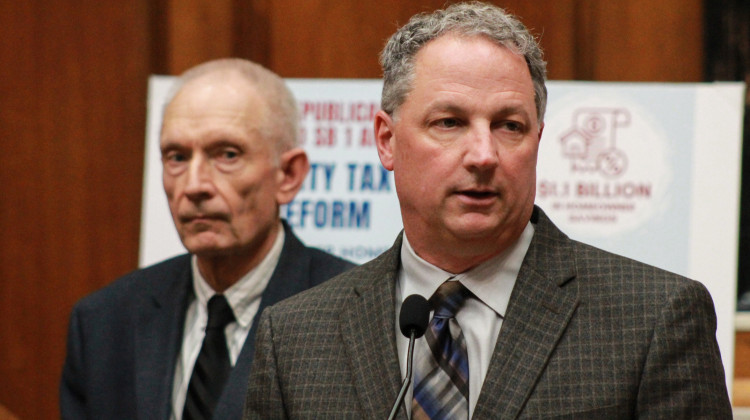
An EPA civil engineer shows how corrosion control treatments can affect lead pipes. The one on the left was treated, the middle one was not, and the one on the right is a new pipe.
Lauren Chapman/IPB NewsThe Environmental Protection Agency wants drinking water utilities to get rid of all their lead water pipes within a decade. That’s according to a proposed lead and copper rule the agency announced on Thursday in a big move to protect kids and vulnerable people from exposure.
The EPA said it’s achievable — cities like Newark, New Jersey; Benton Harbor, Michigan; and Green Bay, Wisconsin were all able to replace their lead pipes within 10 years.
The federal government has also made $50 billion available for water and wastewater infrastructure upgrades — nearly half of that can be used for replacing lead pipes specifically. But that might not be enough, said Gabriel Filippelli, an earth science professor at IUPUI who directs the Indiana University Environmental Resilience Institute.
“I think that the funding that's been set aside for this is probably going to get us about halfway there in that time frame," he said.

A spokesperson for Citizens Energy estimates about 55,000 of its customers in Indianapolis have lead pipes running from their homes or businesses to the utility's water mains. Replacing all of them is expected to cost a total of nearly $500 million.
Kristin Bean is the executive director for the Indiana Alliance of Rural Water. The alliance has been working with communities to help them make inventories of their lead pipes for free. Those are due to the EPA by fall of next year and the proposed rule would require them to be regularly updated.
She said just finding lead pipes can be a challenge for rural water utilities — some of them don’t have good records of where they are.
“It's costly to dig up the ground and take a look and see what's where," Bean said.
Bean said rural communities also often lack the staff to apply for state and federal grants to pay for lead pipe replacements — so the alliance is helping with that too.
Scott Aaron is the Alliance for Indiana Rural Water’s lead service line inventory specialist and also facilitates water training. He said of the nearly 540 rural water systems eligible for the organization's free technical assistance, more than 200 have signed up.
Fortunately for these utilities, Aaron said so far he hasn’t come across many rural water systems that have a high percentage of lead pipes. So once funding is secured, he said getting the work done in a decade may be more achievable for smaller utilities than larger ones.
“Hypothetically speaking, if they have a 100 lead service lines, they only have to replace 10 a year. So if you think about it, you could replace one each month from March through early December,” Aaron said.
The proposed rule would also lower the threshold for when public health agencies address elevated blood lead levels in children to 10 micrograms per deciliter. But Indiana’s threshold is half that and the Centers for Disease Control and Prevention recommends an even lower one.
Rebecca is our energy and environment reporter. Contact her at rthiele@iu.edu or follow her on Twitter at @beckythiele.
 DONATE
DONATE






 Support WFYI. We can't do it without you.
Support WFYI. We can't do it without you.